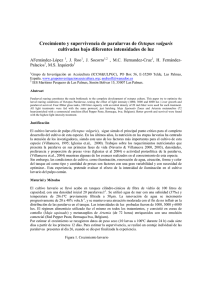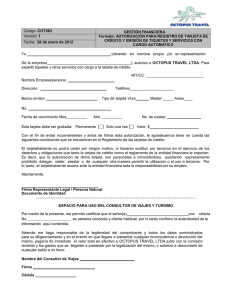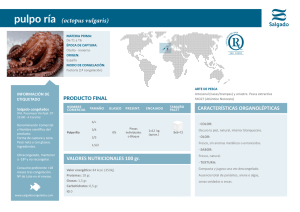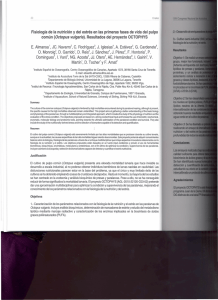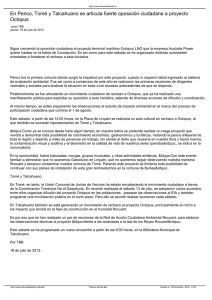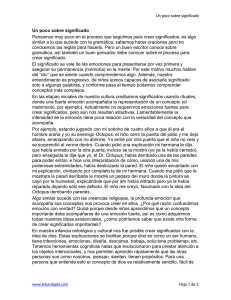Partitioning of Fe, Cu, Zn, Cd, and Pb concentrations among eleven
Anuncio
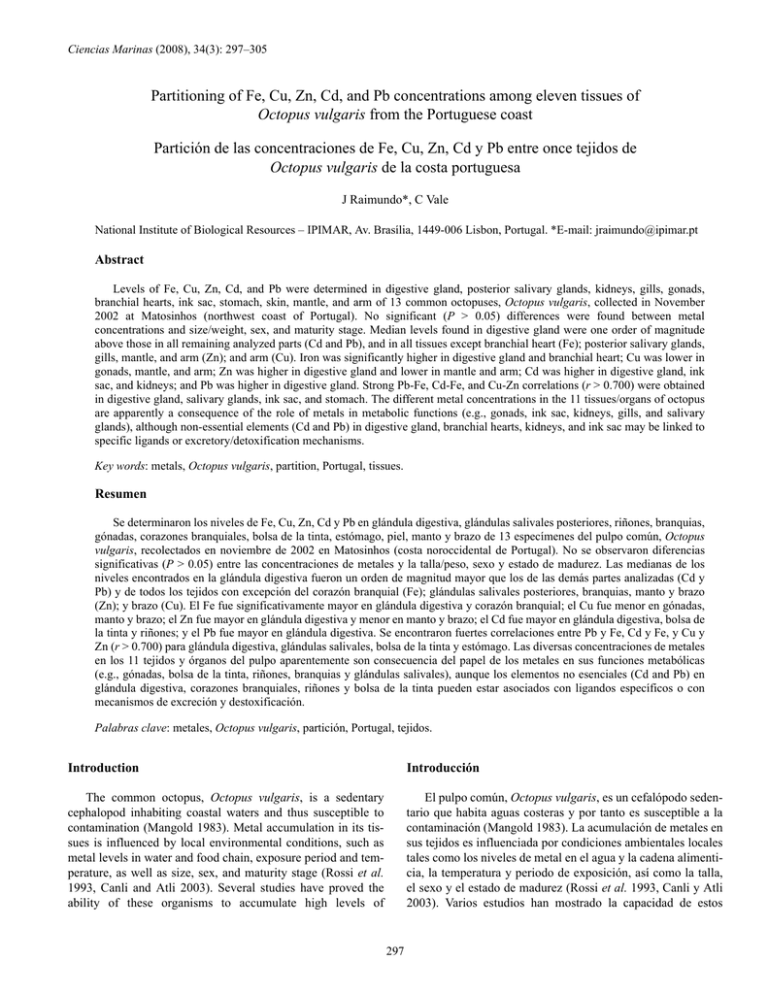
Ciencias Marinas (2008), 34(3): 297–305 Partitioning of Fe, Cu, Zn, Cd, and Pb concentrations among eleven tissues of Octopus vulgaris from the Portuguese coast Partición de las concentraciones de Fe, Cu, Zn, Cd y Pb entre once tejidos de Octopus vulgaris de la costa portuguesa J Raimundo*, C Vale National Institute of Biological Resources – IPIMAR, Av. Brasília, 1449-006 Lisbon, Portugal. *E-mail: [email protected] Abstract Levels of Fe, Cu, Zn, Cd, and Pb were determined in digestive gland, posterior salivary glands, kidneys, gills, gonads, branchial hearts, ink sac, stomach, skin, mantle, and arm of 13 common octopuses, Octopus vulgaris, collected in November 2002 at Matosinhos (northwest coast of Portugal). No significant (P > 0.05) differences were found between metal concentrations and size/weight, sex, and maturity stage. Median levels found in digestive gland were one order of magnitude above those in all remaining analyzed parts (Cd and Pb), and in all tissues except branchial heart (Fe); posterior salivary glands, gills, mantle, and arm (Zn); and arm (Cu). Iron was significantly higher in digestive gland and branchial heart; Cu was lower in gonads, mantle, and arm; Zn was higher in digestive gland and lower in mantle and arm; Cd was higher in digestive gland, ink sac, and kidneys; and Pb was higher in digestive gland. Strong Pb-Fe, Cd-Fe, and Cu-Zn correlations (r > 0.700) were obtained in digestive gland, salivary glands, ink sac, and stomach. The different metal concentrations in the 11 tissues/organs of octopus are apparently a consequence of the role of metals in metabolic functions (e.g., gonads, ink sac, kidneys, gills, and salivary glands), although non-essential elements (Cd and Pb) in digestive gland, branchial hearts, kidneys, and ink sac may be linked to specific ligands or excretory/detoxification mechanisms. Key words: metals, Octopus vulgaris, partition, Portugal, tissues. Resumen Se determinaron los niveles de Fe, Cu, Zn, Cd y Pb en glándula digestiva, glándulas salivales posteriores, riñones, branquias, gónadas, corazones branquiales, bolsa de la tinta, estómago, piel, manto y brazo de 13 especímenes del pulpo común, Octopus vulgaris, recolectados en noviembre de 2002 en Matosinhos (costa noroccidental de Portugal). No se observaron diferencias significativas (P > 0.05) entre las concentraciones de metales y la talla/peso, sexo y estado de madurez. Las medianas de los niveles encontrados en la glándula digestiva fueron un orden de magnitud mayor que los de las demás partes analizadas (Cd y Pb) y de todos los tejidos con excepción del corazón branquial (Fe); glándulas salivales posteriores, branquias, manto y brazo (Zn); y brazo (Cu). El Fe fue significativamente mayor en glándula digestiva y corazón branquial; el Cu fue menor en gónadas, manto y brazo; el Zn fue mayor en glándula digestiva y menor en manto y brazo; el Cd fue mayor en glándula digestiva, bolsa de la tinta y riñones; y el Pb fue mayor en glándula digestiva. Se encontraron fuertes correlaciones entre Pb y Fe, Cd y Fe, y Cu y Zn (r > 0.700) para glándula digestiva, glándulas salivales, bolsa de la tinta y estómago. Las diversas concentraciones de metales en los 11 tejidos y órganos del pulpo aparentemente son consecuencia del papel de los metales en sus funciones metabólicas (e.g., gónadas, bolsa de la tinta, riñones, branquias y glándulas salivales), aunque los elementos no esenciales (Cd and Pb) en glándula digestiva, corazones branquiales, riñones y bolsa de la tinta pueden estar asociados con ligandos específicos o con mecanismos de excreción y destoxificación. Palabras clave: metales, Octopus vulgaris, partición, Portugal, tejidos. Introduction Introducción The common octopus, Octopus vulgaris, is a sedentary cephalopod inhabiting coastal waters and thus susceptible to contamination (Mangold 1983). Metal accumulation in its tissues is influenced by local environmental conditions, such as metal levels in water and food chain, exposure period and temperature, as well as size, sex, and maturity stage (Rossi et al. 1993, Canli and Atli 2003). Several studies have proved the ability of these organisms to accumulate high levels of El pulpo común, Octopus vulgaris, es un cefalópodo sedentario que habita aguas costeras y por tanto es susceptible a la contaminación (Mangold 1983). La acumulación de metales en sus tejidos es influenciada por condiciones ambientales locales tales como los niveles de metal en el agua y la cadena alimenticia, la temperatura y periodo de exposición, así como la talla, el sexo y el estado de madurez (Rossi et al. 1993, Canli y Atli 2003). Varios estudios han mostrado la capacidad de estos 297 Ciencias Marinas, Vol. 34, No. 3, 2008 organismos de acumular altos niveles de elementos esenciales y no esenciales, especialmente en la glándula digestiva (e.g., Martin y Flegal 1975; Miramand y Guary 1980; Finger y Smith 1987; Miramand y Bentley 1992; Bustamante et al. 1998a, 1998b; Raimundo et al. 2004, 2005; Napoleão et al. 2005). La acumulación en otros tejidos se ha relacionado con la presencia de moléculas esenciales para sus funciones específicas, incluyendo mecanismos de excreción y destoxificación (Blaschko y Himms 1954, Ghiretti-Magaldi et al. 1958, Schipp y Hevert 1978, Rainbow y Phillips 1993, Gerpe et al. 2000, Villanueva y Bustamante 2006). A pesar de la gran cantidad de metales que se retienen en la glándula digestiva y su potencial distribución hacia otros tejidos y órganos, sólo se han realizado unos cuantos estudios sobre la partición de metales entre tres y cinco órganos o tejidos del pulpo (e.g., Miramand y Guary 1980, Miramand y Bentley 1992, Nessim y Riad 2003, Napoleão et al. 2005). El propósito de este trabajo fue determinar las concentraciones de Fe, Cu, Zn, Cd y Pb en 11 tipos de tejidos de 13 especímenes de O. vulgaris capturados en noviembre de 2002 en Matosinhos (costa noroccidental de Portugal), sitio que presenta altos niveles de metales (e.g., Cd) en el agua y en pulpos (Caetano y Vale 2003, Raimundo et al. 2004). essential and non-essential elements, especially in the digestive gland (e.g., Martin and Flegal 1975; Miramand and Guary 1980; Finger and Smith 1987; Miramand and Bentley 1992; Bustamante et al. 1998a, 1998b; Raimundo et al. 2004, 2005; Napoleão et al. 2005). Accumulation in other tissues has been related to the presence of molecules vital to their specific functions, including excretion and detoxifying mechanisms (Blaschko and Himms 1954, Ghiretti-Magaldi et al. 1958, Schipp and Hevert 1978, Rainbow and Phillips 1993, Gerpe et al. 2000, Villanueva and Bustamante 2006). Despite the large amounts of metals retained in the digestive gland and their potential distribution among other tissues and organs, only a few studies have examined metal partitioning among three to five organs/tissues of octopus (e.g., Miramand and Guary 1980, Miramand and Bentley 1992, Nessim and Riad 2003, Napoleão et al. 2005). This study reports the concentrations of Fe, Cu, Zn, Cd, and Pb in 11 tissues of the 13 specimens of O. vulgaris captured in November 2002 in the northwest coast of Portugal (landed at Matosinhos), which has been reported to have elevated levels of metals (e.g., Cd) in water and octopus (Caetano and Vale 2003, Raimundo et al. 2004). Material and methods Material y métodos Samples Muestras Thirteen common octopuses, O. vulgaris, were collected in November 2002 from catches of fishermen at Matosinhos on the northwest coast of Portugal (fig. 1). Specimens were stored in individual plastic bags and immediately frozen onboard in order to minimize mobilization of metals among organs/tissues (Martin and Flegal 1975). Weight, mantle length, and sex were determined for each individual. Sexual maturity was also determined based on the procedures proposed by Guerra (1975). The individuals varied in size and weight over broad ranges (135–210 mm and 844–2609 g, respectively), including males (n = 7) and females (n = 6), most of them in maturation (stage II). Good relationships between size and weight were found (r = 0.89, P = 0.001). In the laboratory, digestive gland, posterior salivary glands, kidneys, gills, gonads, branchial hearts, ink sac, stomach, skin, mantle, and arm were totally removed under partial defrost conditions without rupture of tissues. Stomach contents were totally removed when present. After separation, individual tissue samples were freeze-dried, ground, and homogenized for the analysis of Fe, Cu, Zn, Cd, and Pb. Se obtuvieron 13 especímenes del pulpo común O. vulgaris en noviembre de 2002 de las capturas de pescadores de Matosinhos en la costa noroccidental de Portugal (fig. 1). Los especímenes se almacenaron individualmente en bolsas de plástico y se congelaron inmediatamente a bordo para minimizar la movilización de metales entre órganos y tejidos (Martin y Flegal 1975). Se determinaron el peso, largo del manto y sexo de cada individuo. También se determinó la madurez sexual con base en los procedimientos propuestos por Guerra (1975). Los individuos presentaron un gran intervalo de tallas y pesos (135–210 mm y 844–2609 g, respectivamente), incluyendo machos (n = 7) y hembras (n = 6), la mayoría en estado de maduración sexual (estado II). Se encontraron buenas relaciones entre la talla y el peso (r = 0.89, P = 0.001). En el laboratorio se retiraron la glándula digestiva, glándulas salivales posteriores, riñones, branquias, gónadas, corazones branquiales, saco de la tinta, estómago, piel, manto y brazo, en condiciones de descongelación parcial, sin romper los tejidos. En caso de observar contenidos estomacales, éstos fueron retirados en su totalidad. Después de su separación, las muestras individuales de los tejidos fueron liofilizadas, pulverizadas y homogeneizadas para el análisis de Fe, Cu, Zn, Cd y Pb. Analytical procedure Approximately 200 mg of dry tissue were digested with a mixture of HNO3 (65% v/v) and H2O2 (30% v/v) at 60ºC for 12 h, 100ºC for 1 h, and 80ºC for 1 h, according to the method described by Ferreira et al. (1990). All labware was cleaned with HNO3 (20%) for two days and rinsed with Milli-Q water Procedimiento analítico Se digirieron aproximadamente 200 mg de tejido seco con una mezcla de HNO3 (65% v/v) y H2O2 (30% v/v) a 60ºC 298 Raimundo and Vale: Metal concentrations in tissues of Octopus vulgaris durante 12 h, 100ºC durante 1 h y 80ºC durante 1 h, siguiendo el método descrito por Ferreira et al. (1990). Se lavó todo el material de laboratorio con HNO3 (20%) durante dos días, enjuagándose en agua Milli-Q para evitar su posible contaminación. Se determinaron las concentraciones de Fe, Cu, Zn, Cd y Pb mediante espectrometría de absorción atómica con llama (Perkin Elmer AAnalyst 100) o espectrometría de absorción atómica en horno de grafito (Perkin Elmer, Zeeman 4110ZL). Se evaluó la precisión de estos métodos analíticos mediante el análisis de materiales de referencia certificados: DORM-1 y DORM-2 (músculo de pez perro), DOLT-1 y DOLT-2 (hígado de pez perro) y TORT-1 y TORT-2 (hepatopáncreas de langosta). No se observaron diferencias significativas (P ≤ 0.05) entre los valores obtenidos y los certificados. Las concentraciones de metales se presentan como intervalos y medianas (µg g–1 peso seco). Análisis estadístico Antes de realizar el análisis estadístico se comprobó la normalidad y equitatividad de varianzas de las concentraciones de metales y los parámetros biológicos. Se aplicaron la prueba U de Mann-Whitney y la de Kruskal-Wallis a todos los datos para detectar diferencias entre las concentraciones de metales y los parámetros biológicos y los tejidos. Se utilizó una significancia de P < 0.05 para todos los análisis estadísticos, los cuales se realizaron usando el programa Statistica 6.0. Figure 1. Location of the sampling area of Octopus vulgaris on the northwest Portuguese coast (Matosinhos). Figura 1. Localización de la zona de muestreo de Octopus vulgaris en la costa noroccidental de Portugal (Matosinhos). to avoid contamination. Concentrations of Fe, Cu, Zn, Cd, and Pb were determined by flame atomic absorption spectrometry (Perkin Elmer AAnalyst 100) or graphite furnace atomic absorption spectrometry (Perkin Elmer, Zeeman 4110ZL). The accuracy of these analytical methods was assessed by the analysis of international certificate standards: DORM-1 and DORM-2 (dogfish muscle), DOLT-1 and DOLT-2 (dogfish liver), and TORT-1 and TORT-2 (lobster hepatopancreas). Obtained and certified values did not differ significantly (P ≤ 0.05). Metal concentrations are given as ranges and medians (µg g–1, dry weight). Resultados Concentraciones de metales En la figura 2 se muestran la mediana, los percentiles 25 y 75%, los valores mínimo y máximo, así como los valores extremos y alejados de las concentraciones de metales en los tejidos de los pulpos analizados (glándula digestiva, corazones branquiales, riñones, glándulas salivales posteriores, saco de la tinta, branquias, estómago, manto, brazo, piel y gónadas). Las concentraciones de Fe variaron de 8.5 μg g–1 (brazo) a 384 μg g–1 (glándula digestiva), Cu de 8.2 μg g–1 (brazo) a 762 μg g–1 (glándula digestiva), Zn de 43 μg g–1 (brazo) a 667 μg g–1 (glándula digestiva), Cd de 0.024 μg g–1 (glándula salivares posteriores) a 185 μg g–1 (glándula digestiva), y Pb de 0.087 μg g–1 (estómago) a 3.5 μg g–1 (glándula digestiva). Statistical analysis Prior to statistical analysis, metal concentrations and biological parameters were tested for normality and equality of variances. The Mann-Whitney U and Kruskal-Wallis tests were applied to all data in order to detect differences between metal concentrations and biological parameters and tissues. The significance used for statistical analyses was P < 0.05. The statistical analyses were performed using the Statistica 6.0 statistical software system. Efecto de la talla/peso y sexo en la concentración de metales Results Las concentraciones de Fe, Cu, Zn, Cd y Pb en los tejidos analizados no mostraron diferencias significativas (P > 0.05) en la talla/peso, lo que sugiere que el crecimiento ejerció un efecto mínimo sobre la acumulación de metales dentro de los intervalos de talla/peso de los individuos muestreados. Metal concentrations Figure 2 presents the median, 25 and 75% percentiles, minimum and maximum, and the extreme values and outliers, of metal concentrations in the octopi tissues analyzed (digestive 299 Ciencias Marinas, Vol. 34, No. 3, 2008 Figure 2. Median, 25 and 75% percentiles, minimum and maximum, and extreme values ( ) and outliers ({) of Fe, Cu, Zn, Cd, and Pb concentrations (µg g–1 dry weight) in the digestive gland (DG), posterior salivary glands (SG), kidneys (Kd), gills, gonads (Gon), branchial hearts (BH), ink sac (IS), stomach (Stom), skin, mantle (Mt), and arm of common octopus Octopus vulgaris. Figura 2. Mediana, percentiles 25 y 75%, valores mínimo y máximo, y valores extremos ( ) y alejados ({) de las concentraciones de Fe, Cu, Zn, Cd y Pb (µg g–1 peso seco) en glándula digestiva (DG), glándulas salivales posteriores (SG), riñones (Kd), branquias (gills), gónadas (Gon), corazones branquiales (BH), saco de la tinta (IS), estómago (Stom), piel (skin), manto (Mt) y brazo (arm) del pulpo común Octopus vulgaris. Correlaciones metal-metal gland, branchial hearts, kidneys, posterior salivary glands, ink sac, gills, stomach, mantle, arm, skin, and gonads). Iron concentrations ranged from 8.5 μg g–1 (arm) to 384 μg g–1 (digestive gland), Cu from 8.2 μg g–1 (arm) to 762 μg g–1 (digestive gland), Zn from 43 μg g–1 (arm) to 667 μg g–1 (digestive gland), Cd from 0.024 μg g–1 (posterior salivary glands) to 185 μg g–1 (digestive gland), and Pb from 0.087 μg g–1 (stomach) to 3.5 μg g–1 (digestive gland). Sólo se obtuvieron correlaciones entre las concentraciones de metales para glándula digestiva, glándulas salivales posteriores, saco de la tinta y estómago (tabla 1). Se observó una relación entre el Pb y el Fe en todos los tejidos y órganos, con excepción de las glándulas salivales, mientras que en estas últimas el Cd se correlacionó con Fe, Cu y Zn. Diferencias de Fe, Cu, Zn, Cd y Pb entre los tejidos Effect of size/weight and sex on metal concentration Los niveles de Fe en glándula digestiva y corazón branquial fueron significativamente mayores que en todos los tejidos analizados con excepción del saco de la tinta. El estómago, riñones, piel, branquias, manto y brazo mostraron valores similares (fig. 2). Los niveles de Cu en gónadas, manto y brazo fueron significativamente menores que en los demás tejidos y órganos, exceptuando el estómago. La glándula digestiva presentó una gran variabilidad con valores de 28 a 762 μg g–1. El Zn en glándula digestiva fue estadísticamente mayor que en manto y brazo (valores bajos) y en los demás tejidos (valores intermedios). Las gónadas presentaron valores significativamente diferentes a los de otros tejidos, con excepción del saco de la tinta. Las glándulas salivales posteriores, riñones, branquias, corazones branquiales, estómago y piel mostraron concentraciones similares. La partición de Cd resultó ser la más Concentrations of Fe, Cu, Zn, Cd, and Pb in the tissues analyzed showed no significant (P > 0.05) differences in size/ weight, suggesting that growth has minor effects on metal accumulation within the size/weight ranges of the sampled individuals. Metal-metal correlations The correlations between metal concentrations were only obtained for digestive gland, posterior salivary glands, ink sac, and stomach (table 1). The Pb-Fe relationship was found in all these tissues/organs except in salivary glands. Cadmium was correlated to Fe, Cu, and Zn in salivary glands. 300 Raimundo and Vale: Metal concentrations in tissues of Octopus vulgaris Table 1. Metal-metal correlations (r) and associated probabilities (a, 0.05; b, 0.01; c, 0.001) in the digestive gland, salivary glands, ink sac, and stomach of Octopus vulgaris captured at Matosinhos. Tabla 1. Correlaciones metal-metal (r) y sus probabilidades asociadas (a, 0.05; b, 0.01; c, 0.001) en glándula digestiva, glándulas salivales, bolsa de la tinta y estómago de Octopus vulgaris capturado en Matosinhos. Differences of Fe, Cu, Zn, Cd, and Pb among tissues Levels of Fe in the digestive gland and branchial heart were significantly higher than in all the tissues analyzed, except ink sac. Stomach, kidneys, skin, gills, mantle, and arm exhibited similar values (fig. 2). Copper levels in gonads, mantle and arm were significantly lower than in the other tissues and organs, with the exception of the stomach. Digestive gland exhibited high variability, ranging from 28 to 762 μg g–1. Zinc in the digestive gland was statistically higher than in mantle and arm (low) and in all the other tissues (intermediate values). Gonads exhibited significantly different values from the other tissues, except ink sac. Posterior salivary glands, kidneys, gills, branchial hearts, stomach, and skin presented similar concentrations. The partitioning of Cd was clearer since levels in the digestive gland, ink sac, and kidney were significantly higher than in all the other tissues and organs analyzed. Digestive gland also presented significantly higher levels of Pb. Salivary glands showed lower Pb than the other tissues, with the exception of skin, ink sac, and stomach. clara ya que los niveles en glándula digestiva, saco de la tinta y riñones fueron significativamente mayores que en todos los demás tejidos y órganos analizados. La glándula digestiva también presentó niveles significativamente mayores de Pb. Se registraron niveles más bajos de Pb en las gándulas salivales que en los demás tejidos, con excepción de la piel, el saco de la tinta y estómago. Discussion Discusión Comparison with other studies Comparación con otros trabajos The lack of relationships between size/weight and sex with metal concentrations is in line with other studies reporting similar concentrations in small and large individuals of other octopus species, Graneledone sp. and Benthoctopus thielei (Bustamante et al. 1998a), and of the same species (Seixas et al. 2005); however, Octopus salutii showed a negative relationship between Cd concentrations and weight (Storelli and Marcotrigiano 1999). Furthermore, metal concentration did not differ between males and females, which agrees with other cephalopod studies (Miramand and Bentley 1992, Bustamante et al. 1998a, Barghigiani et al. 2000), though higher levels of Fe have been detected in females (Seixas et al. 2005). Due to the absence of relationships, the 11 specimens were treated independently of their size and sex. Comparing with other studies, the Fe, Cu, Zn, and Pb levels fall within the concentration ranges of each tissue reported for O. vulgaris from various coastal waters (table 2). The Cd levels in tissues of octopus from the northwest Portuguese coast exceeded some of the values reported in the literature, which may be attributed to the high availability of Cd in coastal waters associated with river inputs (Caetano and Vale 2003, Raimundo et al. 2004). Accumulated metals in organs/tissues La ausencia de relaciones entre talla/peso y sexo con las concentraciones de metales concuerda con otros estudios que registraron concentraciones similares en individuos pequeños y grandes de otras especies de pulpo, Graneledone sp. y Benthoctopus thielei (Bustamante et al. 1998a), y de la misma especie (Seixas et al. 2005); sin embargo, Octopus salutii presentó una relación negativa entre las concentraciones de Cd y el peso (Storelli y Marcotrigiano 1999). Además, las concentraciones de metales no difirieron entre machos y hembras, lo que también concuerda con otros estudios de cefalópodos (Miramand y Bentley 1992, Bustamante et al. 1998a, Barghigiani et al. 2000), aunque se han detectado mayores niveles de Fe en hembras (Seixas et al. 2005). Debido a la ausencia de relaciones, los 11 especímenes se trataron independientemente de su talla y sexo. Al comparar con otros trabajos se observó que los niveles de Fe, Cu, Zn y Pb se encuentran dentro de los intervalos de concentración de cada tejido registrados para O. vulgaris de otras aguas costeras (tabla 2). Los niveles de Cd en los tejidos del pulpo de la costa noroccidental de Portugal excedieron algunos de los valores encontrados en la literatura, lo cual puede atribuirse a la gran disponibilidad de Cd en aguas costeras relacionada con las descargas de ríos (Caetano y Vale 2003, Raimundo et al. 2004). Digestive gland Metales acumulados en órganos y tejidos The digestive gland exhibited the highest metal concentrations. Medians were one order of magnitude above those in all other analyzed parts (Cd and Pb), and in all tissues except branchial heart (Fe); posterior salivary glands, gills, mantle, Glándula digestiva Fe Pb Cd Cu Zn Digestive gland Pb 0.85b – 0.939c – – Ink sac Pb 0.918c – – – – Stomach Pb 0.729a – – – – Salivary glands Cd 0.922c 0.700a – 0.968c 0.726a La glándula digestiva presentó las mayores concentraciones de metales. Las medianas fueron un orden de magnitud 301 Ciencias Marinas, Vol. 34, No. 3, 2008 Table 2. Comparison of Fe, Zn, Cu, Cd, and Pb levels (µg g–1 dry weight) in the digestive gland, branchial hearts, gills, gonads, posterior salivary glands, mantle, arm, and mantle skin of Octopus vulgaris from Matosinhos (present study) with data from the literature. Tabla 2. Comparación de los niveles de Fe, Zn, Cu, Cd y Pb (µg g–1 peso seco) en glándula digestiva, corazones branquiales, branquias, gónadas, glándulas salivales posteriores, manto, brazo y piel del manto de Octopus vulgaris de Matosinhos (este estudio) con datos disponibles en la literatura. Organ/tissue of O. vulgaris Fe Cu Zn Cd Pb Digestive gland 142–384 – – 790 ± 343 700 ± 130 130–875 28–762 139–3140 137–1465 1768 ± 1010 2500 ± 700 8.6–286 81–667 200–14721 198–14721 1463 ± 726 1450 ± 400 113–437 94–185 19–761 20–269 – 50 ± 10 34–218 0.71–3.5 0.037–44 – 6.9 ± 3.2 – – Present study Raimundo et al. (2004) Raimundo et al. (2005) Napoleão et al. (2005) Miramand and Guary (1980) Soldevilla (1987) Branchial hearts 95–1270 650 ± 150 577 ± 323 41–69 92–274 500 ± 40 188 ± 68 14–58 68–386 65 ± 15 81 ± 23 58–121 0.032–88 0.08 ± 0.04 – 2.5–3.8 0.39–3.9 – 8.1 ± 5.0 8.3–9.4 Present study Miramand and Guary (1980) Napoleão et al. (2005) Nessim and Riad (2003) Gills 10–252 40 ± 28 19–87 11–16 66–128 113 ± 47 92–253 11–21 76–122 72 ± 17 44–94 24–38 0.16–22 – 17 1.2–2.0 0.25–1.1 – – 2.1–4.4 Present study Napoleão et al. (2005) Soldevilla (1987) Nessim and Riad (2003) Gonads 12–29 30 ± 10 18–28 11–46 50 ± 8 27–42 92–357 360 ± 200 8.1–26 0.067–2.0 0.1 ± 0.04 1.0–2.6 0.54–0.85 – 1.5–15 Present study Miramand and Guary (1980) Nessim and Riad (2003) 15–79 19–32 34–195 12–36 59–182 56–116 0.024–18 3.1–4.4 0.20–0.67 2.0–23 Present study Nessim and Riad (2003) Mantle 17–43 11–84 30 ± 5 8.7–48 24 ± 15 14–81 11–16 8.3–62 17–106 26 ± 1 13–99 30 ± 19 12–68 13–20 47–64 41–186 70 ± 30 59–193 76 ± 22 67–121 5.2–13 0.25–4.4 23 0.08 ± 0.04 0.13–11.1 – 0.27–3.3 1.3–1.8 0.30–1.6 – – 0.056–4.3 – – 1.8–7.4 Present study Soldevilla (1987) Miramand and Guary (1980) Raimundo et al. (2004) Napoleão et al. (2005) Raimundo et al. (2005) Nessim and Riad (2003) Arm 8.5–60 14–58 40–50 5.7–49 10–76 8.2–16 5.5–72 4–203 5.5–20 7.8–36 43–66 53–107 50–300 64–119 53–75 0.11–0.26 0.035–1.0 20 0.053–1.3 1.8 0.29–2.2 – 3–4 0.058–0.87 – Present study Raimundo et al. (2005) Seixas et al. (2005) Raimundo et al. (2004) Soldevilla (1987) Skin 22–87 30 ± 10 11–19 36–98 50 ± 4 12–18 73–123 50 ± 10 11–16 0.16–3.2 0.04 ± 0.01 1.4–2.3 0.36–1.0 – 3.6–7.4 Posterior salivary glands Reference Present study Miramand and Guary (1980) Nessim and Riad (2003) mayor que las de todas las otras partes analizadas (Cd y Pb) y de todos los tejidos con excepción del corazón branquial (Fe); glándulas salivales posteriores, branquias, manto y brazo (Zn); y brazo (Cu). Los niveles elevados corroboran la presencia de and arm (Zn); and arm (Cu). The elevated levels corroborate the presence of efficient mechanisms to store metals in this organ (e.g., Martin and Flegal 1975; Miramand and Guary 1980; Smith et al. 1984; Miramand and Bentley 1992; 302 Raimundo and Vale: Metal concentrations in tissues of Octopus vulgaris mecanismos eficientes para almacenar metales en este órgano (e.g., Martin y Flegal 1975; Miramand y Guary 1980; Smith et al. 1984; Miramand y Bentley 1992; Bustamante et al. 1998a, 1998b, 2002; Raimundo et al. 2004; Napoleão et al. 2005; Seixas et al. 2005). En cefalópodos se ha usado la razón entre las concentraciones de metales en glándula digestiva y músculo para separar los elementos en tres grupos (Miramand y Bentley 1992): poco concentrados (razón < 10), moderadamente concentrados (10 < razón < 50) y altamente concentrados (razón > 50). El cálculo de esta razón mostró poca concentración de Pb (razón: 4–6); concentraciones moderadas de Fe (razón: 11–13), Cu (razón: 17–20) y Zn (razón: 11–12); y una alta concentración de Cd (razón: 98–585). La fuerte asociación del Cd con las lisosomas y proteínas citosólicas (Finger y Smith 1987, Castillo y Maita 1991, Bustamante et al. 2002) parece ser más notable en pulpos de la región noroccidental de Portugal, probablemente como consecuencia de una mayor disponibilidad de este metal (Caetano y Vale 2003). Bustamante et al. 1998a, 1998b, 2002; Raimundo et al. 2004; Napoleão et al. 2005; Seixas et al. 2005). In cephalopods, the ratio between metal concentrations in digestive gland and muscle has been used to separate elements into three groups (Miramand and Bentley 1992): poorly concentrated (ratio < 10), moderately concentrated (10 < ratio < 50), and highly concentrated (ratio > 50). The calculation of this ratio showed that Pb (ratio: 4–6) was poorly concentrated; Fe (ratio: 11–13), Cu (ratio: 17–20), and Zn (ratio: 11–12) were moderately concentrated; and Cd (ratio: 98–585) was highly concentrated. The strong association of Cd with lysosomes and cytosolic proteins (Finger and Smith 1987, Castillo and Maita 1991, Bustamante et al. 2002) appears to be emphasized in octopus from the northwestern region of Portugal probably due to higher availability (Caetano and Vale 2003). Gills and stomach The high levels of Cu in gills are in line with other studies (Soldevilla 1987) that linked its abundance to hemocyanin, Cu being one of the main components of this respiratory pigment (Soldevilla 1987, Craig and Overnell 2003, Villanueva and Bustamante 2006). Iron, Zn, and Cd were higher in the stomach, while Cu and Pb showed increased concentrations in gills, suggesting preferential uptake through food or water. Branquias y estómago Los altos niveles de Cu en las branquias concuerdan con lo encontrado en otros trabajos (Soldevilla 1987) que relacionaron su abundancia con la hemocianina, ya que este metal es uno de los componentes principales de este pigmento respiratorio (Soldevilla 1987, Craig y Overnell 2003, Villanueva y Bustamante 2006). Los niveles de Fe, Zn y Cd fueron mayores en el estómago, mientras que Cu y Pb mostraron concentraciones mayores en las branquias, lo que indica una captación preferencial a través de la comida o el agua. Mantle, arms, and skin As reported previously (Raimundo et al. 2004), the levels of Cd and Pb in mantle were significantly higher than in arm, pointing to efficient binding sites in that tissue. Different protein composition (Kariya et al. 1986) may contribute to the distinct accumulation. Iron, Zn, and Cu were more concentrated in skin than in mantle and arms. These differences were found in other studies (Miramand and Guary 1980, Miramand and Bentley 1992), suggesting changes in environmental availability. Since these tissues are consumed by humans, the levels were compared to the safety limit established by the European Commission (1.0 µg g–1 w.w. of Cd and Pb, Journal of the European Communities 2001, EC rule no. 466/2001). Tissues of only 4 of the 13 specimens analyzed presented Cd and Pb levels above these limits (Cd = 1.1, 1.2, and 3.1 µg g–1; and Pb = 1.5 µg g–1). Manto, brazos y piel Al igual que lo previamente reportado por Raimundo et al. (2004), los niveles de Cd y Pb en el manto fueron significativamente mayores que en el brazo, lo que indica la existencia de sitios de captación eficientes en ese tejido. Una composición diferente de proteínas (Kariya et al. 1986) puede contribuir a una distinta acumulación. El Fe, Zn y Cu se concentraron más en la piel que en el manto y los brazos. En otros estudios se han encontrado diferencias similares (Miramand y Guary 1980, Miramand y Bentley 1992), lo cual sugiere cambios en la disponibilidad ambiental de estos elementos. Como estos tejidos se destinan al consumo humano, se compararon sus niveles de metal con el límite de seguridad establecido por la Comisión Europea (1.0 µg g–1 p.h. de Cd y Pb, Journal of the European Communities 2001, reglamento número 466/2001). Los tejidos de sólo 4 de los 13 especímentes analizados presentaron niveles de Cd y Pb por encima de estos límites (Cd = 1.1, 1.2 y 3.1 µg g–1; y Pb = 1.5 µg g–1). Salivary glands Copper was the main concentrated metal in the salivary gland of the octopuses containing a mixture of several toxic substances used to kill the prey (Kanda et al. 2003). Abundant Cu in O. vulgaris has been observed by Nessim and Riad (2003) and may be related to Cu-amine oxidase (Blaschko and Himms 1954). Glándulas salivales El Cu fue el principal metal concentrado en las glándulas salivales del pulpo, las cuales contienen una mezcla de varias 303 Ciencias Marinas, Vol. 34, No. 3, 2008 Branchial hearts sustancias tóxicas para matar a sus presas (Kanda et al. 2003). Nessim y Riad (2003) observaron una abundancia de Cu en O. vulgaris que puede asociarse con la amina oxidasa que contiene Cu (Blaschko y Himms 1954). The high levels of Fe and Cu in branchial hearts agree with the findings of Miramand and Guary (1980) for the same species on the coast of Monaco. The presence of adenochromes may be responsible for Fe complexation (Ghiretti-Magaldi et al. 1958), and of respiratory pigment hemocyanin by the elevated Cu (Miramand and Guary 1980). Branchial hearts also presented enhanced levels of Cd and Pb that may be related to storage and detoxification mechanisms (Guary and Fowler 1982) linked to the circulatory and excretory functions of these organs (Schipp and Hevert 1978, Villanueva and Bustamante 2006). Corazones branquiales Los altos niveles de Fe y Cu en corazones branquiales concuerdan con lo registrado por Miramand y Guary (1980) para la misma especie en la costa de Mónaco. La presencia de adenocromos puede ser responsable de la complejación del Fe (Ghiretti-Magaldi et al. 1958), así como del pigmento respiratorio hemocianina por el alto nivel de Cu (Miramand y Guary 1980). Los corazones branquiales también presentaron mayores niveles de Cd y Pb, posiblemente relacionados con los mecanismos de almacenamiento y destoxificación (Guary y Fowler 1982) asociados con las funciones de circulación y excreción de estos órganos (Schipp y Hevert 1978, Villanueva y Bustamante 2006). Kidneys The kidney concentrated elevated levels of Pb, as well as of Cd and Cu which have been registered in Eledone cirrhosa and Sepia officinalis (Miramand and Bentley 1992) and O. vulgaris (Miramand and Guary 1980), and interpreted as the result of the excretory function (Rainbow and Phillips 1993). Riñones Ink sac Los riñones concentraron niveles altos de Pb, así como de Cd y Cu, los mismos que han sido registrados en Eledone cirrhosa y Sepia officinalis (Miramand y Bentley 1992) y en O. vulgaris (Miramand y Guary 1980), lo cual fue interpretado como un efecto de su función excretora (Rainbow y Phillips 1993). The high levels of Cu and Zn may be associated with melanin (Bustamante et al. 1998a), and Cd related to excretory pathway of the ink. Gonads The gonads presented enhanced levels of Zn, concurring with different studies (Miramand and Guary 1980, Miramand and Bentley 1992, Bustamante et al. 1998a, Gerpe et al. 2000) and related to high quantities of Zn-containing enzymes and metalloproteins (Gerpe et al. 2000). Saco de la tinta Los altos niveles de Cu y Zn en el saco de la tinta pueden estar asociados con la melanina (Bustamante et al. 1998a), y los de Cd con la vía de excreción de la tinta. In summary, metal concentrations differed considerably among the 11 tissues/organs of octopus, apparently as a consequence of the role of metals in metabolic functions (e.g., gonads, ink sac, kidneys, gills, and salivary glands). The presence of non-essential elements (Cd and Pb) in the digestive gland, branchial hearts, kidney, and ink sac may be linked to specific ligands or excretory/detoxification mechanisms. Gónadas Las gónadas presentaron elevados niveles de Zn, lo cual concuerda con otros trabajos (Miramand y Guary 1980, Miramand y Bentley 1992, Bustamante et al. 1998a, Gerpe et al. 2000) y se ha relacionado con la gran cantidad de metaloproteínas y enzimas que contienen Zn (Gerpe et al. 2000). Acknowledgements En resumen, las concentraciones de metales difirieron considerablemente entre los 11 tejidos y órganos del pulpo, aparentemente como consecuencia del papel de los metales en sus funciones metabólicas (e.g., gónadas, saco de la tina, riñones, branquias y glándulas salivales). La presencia de elementos no esenciales (Cd y Pb) en glándula digestiva, corazones branquiales, riñones y saco de la tinta puede estar relacionado con ligandos específicos o con mecanismos de excreción y destoxificación. This work was supported by the Portuguese Foundation for Science and Technology (project “Cadmium detoxification in cephalopods”). References Barghigiani C, Ristori T, Biagi F, de Reneri S. 2000. Size-related mercury accumulations in edible marine species from an area of the northern Tyrrhenian Sea. Water, Air, Soil Pollut. 124: 169–176. 304 Raimundo and Vale: Metal concentrations in tissues of Octopus vulgaris Agradecimientos Blaschko H, Himms J. 1954. Enzymic oxidation of amines in decapods. J. Exp. Biol. 31: 2–7. Bustamante P, Cherel Y, Caurant F, Miramand P. 1998a. Cadmium, copper and zinc in octopuses from Kerguelen Islands, Southern Indian Ocean. Polar Biol. 19: 264–271. Bustamante P, Caurant F, Fowler S, Miramand P. 1998b. Cephalopods as a vector for the transfer of cadmium to top marine predators in the north-east Atlantic Ocean. Sci. Total Environ. 220: 71–80. Bustamante P, Cosson R, Gallien I, Caurant F, Miramand P. 2002. Cadmium detoxification processes in the digestive gland of cephalopods in relation to accumulated cadmium concentrations. Mar. Environ. Res. 53: 227–241. Caetano M, Vale C. 2003. Trace-elemental composition of seston and plankton along the Portuguese coast. Acta Oecol. 24: S341–S349. Canli M, Atli G. 2003. The relationships between heavy metal (Cd, Cr, Cu, Fe, Pb, Zn) levels and the size of six Mediterranean fish species. Environ. Pollut. 121: 129–136. Castillo L, Maita Y. 1991. Isolation and partial characterisation of cadmium binding proteins from the oceanic squid, Ommastrephes bartrami. Bull. Fac. Fish. Hokkaido Univ. 42: 26–34. Craig S, Overnell J. 2003. Metals in squid, Loligo forbesi, eggs and hatchlings. No evidence for a role for Cu- or Zn-metallothionein. Comp. Biochem. Physiol. 134C: 311–317. Ferreira A, Cortesão C, Castro O, Vale C. 1990. Accumulation of metals and organochlorines in tissues of the oyster Crassostrea angulata from the Sado Estuary. Sci. Total Environ. 97/98: 627–639. Finger J, Smith J. 1987. Molecular association of Cu, Zn, Cd and 210Po in the digestive gland of the squid Nototodarus gouldi. Mar. Biol. 95: 87–91. Gerpe M, de Moreno J, Patat M. 2000. Cadmium, zinc and copper accumulation in the squid Illex argentinus from the southwest Atlantic Ocean. Mar. Biol. 136: 1039–1044. Ghiretti-Magaldi A, Giuditta A, Ghiretti F. 1958. Pathways of terminal respiration in marine invertebrates. I. The respiratory system in cephalopods. J. Cell. Comp. Physiol. 52: 389–429. Guary J, Fowler S. 1982. Experimental studies on the biokinetics of plutonium and americium in the cephalopod Octopus vulgaris. Mar. Ecol. Prog. Ser. 7: 327–335. Guerra A. 1975. Determinación de las diferentes fases del desarrollo sexual de Octopus vulgaris Lamarck, mediante un índice de madurez. Invest. Pesq. 39: 397–416. Kanda A, Iwakoshi-Ukena E, Takuwa-Kuroda K, Minakata H. 2003. Isolation and characterization of novel tachykinins from the posterior salivary gland of the common octopus Octopus vulgaris. Peptides 24: 35–43. Kariya Y, Ochiai Y, Hashimoto K. 1986. Protein components and ultrastructure of the arm and mantle muscles of octopus Octopus vulgaris. Bull. Japan Soc. Sci. Fish. 52: 131–138. Mangold K. 1983. Octopus vulgaris. In: Boyle P (ed.), Cephalopod Life Cycles, Species Accounts. Academic Press, UK, pp. 335–364. Martin J, Flegal A. 1975. High copper concentrations in squid livers in association with elevated levels of silver, cadmium and zinc. Mar. Biol. 30: 51–55. Miramand P, Guary J. 1980. Association of americium-241 with adenochromes in the branchial hearts of the cephalopod Octopus vulgaris. Mar. Ecol. Prog. Ser. 4: 127–129. Este trabajo recibió apoyo de la Fundación de Ciencia y Tecnología de Portugal (proyecto “Destoxificación de cadmio en cefalópodos”). Traducido al español por Christine Harris. Miramand P, Bentley D. 1992. Concentration and distribution of heavy metals in tissues of two cephalopods, Eledone cirrhosa and Sepia officinalis, from the French coast of the English Channel. Mar. Biol. 114: 407–414. Napoleão P, Pinheiro T, Sousa Reis C. 2005. Elemental characterization of tissues of Octopus vulgaris along the Portuguese coast. Sci. Total Environ. 345:41–49. Nessim R, Riad R. 2003. Bioaccumulation of heavy metals in Octopus vulgaris from coastal waters of Alexandria (eastern Mediterranean). Chem. Ecol. 19: 275–281. Raimundo J, Caetano M, Vale C. 2004. Geographical variation and partition of metals in tissues of Octopus vulgaris along the Portuguese coast. Sci. Total Environ. 325: 71–81. Raimundo J, Pereira P, Vale C, Caetano M. 2005. Fe, Zn, Cu and Cd in the digestive gland and muscle tissues of Octopus vulgaris and Sepia officinalis from coastal areas in Portugal. Cienc. Mar. 31: 243–251. Rainbow P, Phillips D. 1993. Cosmopolitan biomonitors of trace metals. Mar. Pollut. Bull. 26: 593–601. Rossi A, Pellegrini D, Belcari P, Barghigiani C. 1993. Mercury in Eledone cirrhosa from the northern Tyrrhenian Sea: Contents and relations with life cycle. Mar. Pollut. Bull. 26: 683–686. Schipp R, Hevert F. 1978. Distribution of copper and iron in some central organs of Sepia officinalis (Cephalopoda). A comparative study by flameless atomic absorption and electron microscopy. Mar. Biol. 47: 391–399. Seixas S, Bustamante P, Pierce G. 2005. Accumulation of mercury in the tissues of the common octopus Octopus vulgaris (L.) in two localities on the Portuguese coast. Sci. Total Environ. 340: 113–122. Smith J, Plues L, Heyraud M, Cherry R. 1984. Concentrations of the elements Ag, Al, Ca, Cd, Cu, Fe, Mg, Mn, Pb and Zn, and the radionuclides 219Pb and 210Po in the digestive gland of the squid Nototodarus gouldi. Mar. Environ. Res. 13: 55–68. Soldevilla F. 1987. Metales pesados en el pulpo común (Octopus vulgaris) del banco sahariano (costas NO de Africa). Alimentaria 33: 33–37. Storelli M, Marcotrigiano G. 1999. Cadmium and total mercury in some cephalopods from the South Adriatic Sea (Italy). Food Addit. Contam. 16: 261–265. Villanueva R, Bustamante P. 2006. Composition in essential and nonessential elements of early stages of cephalopods and dietary effects on the elemental profiles of Octopus vulgaris paralarvae. Aquaculture 261: 225–240. Recibido en febrero de 2008; aceptado en agosto de 2008. 305
